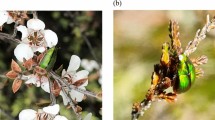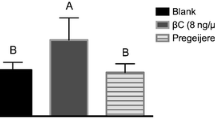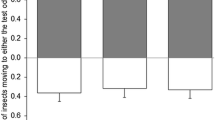Abstract
We report here a first survey of insect orientation to fungal cultures and fungal volatiles from a community ecology perspective. We tested whether volatiles from a ubiquitous yeast-like fungus (Aureobasidium pullulans) are broadly attractive to insects in an agricultural landscape. We evaluated insect attraction to fungal cultures and synthetic compounds identified in fungal headspace (2-methyl-1-butanol, 3-methyl-1-butanol, 2-phenylethanol) in a spearmint (Mentha spicata L.) plantation. Three findings emerged: (1) 1,315 insects representing seven orders and 39 species oriented to traps, but 65 % of trapped insects were Dipterans, of which 80 % were hoverflies (Diptera: Syrphidae); (2) traps baited with A. pullulans caught 481 % more insects than unbaited control traps on average, and contained more diverse (Shannon’s H index) and species rich assemblages than control traps, traps baited with Penicillium expansum, or uninoculated media; and (3) insects oriented in greatest abundance to a 1:1:1 blend of A. pullulans volatiles, but mean diversity scores were highest for traps baited with only 2-phenylethanol or 2-methyl-1-butanol. Our results show that individual components of fungal headspace are not equivalent in terms of the abundance and diversity of insects that orient to them. The low abundance of insects captured with P. expansum suggests that insect assemblages do not haphazardly orient to fungal volatiles. We conclude that volatiles from a common fungal species (A. pullulans) are attractive to a variety of insect taxa in an agricultural system, and that insect orientation to fungal volatiles may be a common ecological phenomenon.




Similar content being viewed by others
References
Becher, P. G., Flick, G., Rozpędowska, E., Schmidt, A., Hagman, A., Lebreton, S., Larsson, M. C., Hansson, B. S., Piškur, J., Witzgall, P., and Bengtsson, M. 2012. Yeast, not fruit volatiles mediates Drosophila melanogaster attraction, oviposition and development. Functional Ecol. 26:822–828. doi: 10.1111/j.1365-2435.2012.02006.x
Beltran, G., Novo, M., Guillamon, J. G., Mas, A., and Rozes, A. 2008. Effect of fermentation temperature and culture media on the yeast lipid composition and wine volatile compounds. Int. J. Food Microbiol. 121:169–177.
Blomquist, G. J. and Vogt, R. C. 2003. Insect pheromone biochemistry and molecular biology. Elsevier Academic Press, San Diego, CA, USA. 768 p.
Cha, D. H., Adams, T., Rogg, H., and Landolt, P. J. 2012. Identification and field evaluation of fermentation volatiles from wine and vinegar that mediate attraction of spotted wing drosophila, Drosophila suzukii. J. Chem. Ecol. 38:1419–1431.
Chambers, R. J. 1986. Preliminary experiments on the potential of hoverflies (Dipt.:Syrphidae) for the control of aphids under glass. Entomophaga 31:197–204.
Davis, T. S., Boundy-Mills, K., and Landolt, P. J. 2012. Volatile emissions from an epiphytic fungus are semiochemicals for eusocial wasps. Microb. Ecol. 64:1059–1064.
De Jager, E. S., Wehner, F. C., and Korsten, L. 2001. Microbial ecology of the mango phylloplane. Microb. Ecol. 42:201–207.
El-Sayed, A. M., Heppelthwaite, V. J., Manning, L. M., Gibb, A. R., and Suckling, D. M. 2005. Volatile constituents of fermented sugar baits and their attraction to Lepidopteran species. J. Agric. Food Chem. 53:953–958.
Fischer, G., Schwalbe, R., Moller, M., Ostrowski, R., and Dott, W. 1999. Species-specific production of microbial volatile organic compounds (MVOC) by airborne fungi from a compost facility. Chemosphere 39:795–810.
Goodrich, K. R., Zjhra, M. L., Ley, C. A., and Raguso, R. A. 2006. When flowers smell fermented: the chemistry and ontogeny of yeasty floral scent in Pawpaw (Asimina triloba: Annonaceae). Int. J. Plant Sci. 167:33–46.
Hansson, B. S. 1999. Insect Olfaction. Springer-Verlag, Berlin, Heidelberg, Germany. 457 p.
Heath, R. R. and Manukian, A. 1992. Development and evaluation of systems to collect volatile semiochemicals from insects and plants using charcoal-infused medium for air purification. J. Chem. Ecol. 18:1209–1226.
Hulcr, J., Mann, R., and Stelinski, L. L. 2011. The scent of a partner: ambrosia beetles are attracted to volatiles from their fungal symbionts. J. Chem. Ecol. 37:1374–1377.
Kourkoutas, Y., Komaitis, M., Koutinas, A. A., and Kanellaki, M. 2001. Wine production using yeast immobilized on apple pieces at low room temperatures. J. Agric. Food Chem. 49:1417–1425.
Landolt, P. J. and Alfaro, J. F. 2001. Trapping Lacanobia subjuncta, Xestia c-nigrum, and Mamestra configurata (Lepidoptera: Noctuidae) with acetic acid and 3-methyl-1-butanol in controlled release dispensers. Environ. Entomol. 30:656–662.
Landolt, P. J., Adams, T., and Rogg, H. 2012a. Trapping spotted wing Drosophila, Drosophila suzukii (Matsumura) (Diptera: Drosophilidae) with combination of vinegar and wine, and acetic acid and ethanol. J. Appl. Entomol. 136:148–154.
Landolt, P. J., Adams, T., Davis, T., and Rogg, H. 2012b. Spotted wing Drosophila, Drosophila suzukii (Matsumura) (Diptera: Drosophilidae), trapped with combinations of wines and vinegars. Fla. Entomol. 95:326–332.
Mattheis, J. P. and Roberts, R. G. 1992. Identification of geosmin as a volatile metabolite of Penicillium expansum. Appl. Environ. Microbiol. 58:3170–3172.
Mburu, D. M., Maniania, N. K., and Hassanali, A. 2012. Comparison of volatile blends and nucleotide sequences of two Beauvaria bassiana isolates of different virulence and repellency towards the termite Macrotermes michealseni. J. Chem. Ecol. 39:101–108.
Nout, M. J. R. and Bartelt, R. J. 1998. Attraction of a flying nitidulid (Carpophilus humeralis) to volatiles produced by yeasts grown on sweet corn and corn-based medium. J. Chem. Ecol. 24:1217–1239.
Raguso, R. A. 2008. Wake up and smell the roses: the ecology and evolution of floral scent. Annu. Rev. Ecol. Evol. Syst. 39:549–569.
Reed, H. C. and Landolt, P. J. 2002. Trap response of Michigan social wasps (Hymenoptera: Vespidae) to the feeding attractants acetic acid, isobutanol, and heptyl butyrate. Great Lakes Entomol. 51:71–77.
Renouf, V., Claisse, O., and Lonvaud-Funel, A. 2008. Understanding the microbial ecosystem on the grape berry surface through numeration and identification of yeast and bacteria. Aust. J. Grape Wine Res. 11:316–327.
Rohlfs, M. and Churchill, A. 2011. Fungal secondary metabolites as modulators of interactions with insects and other arthropods. Fungal Genet. Biol. 48:23–34.
Ryan, M. F. 2002. pp. 113–138, Insect chemoreception: Fundamental and applied. Kluwer Academic Publishers, Dordrecht, Netherlands.
Sadeghi, H. and Gilbert, F. 2001. The effect of egg load and host deprivation on oviposition behavior in aphidophagous hoverflies. Ecol. Entomol. 25:101–108.
Schneider, D. 1969. Insect olfaction: deciphering system for chemical messages. Science 163:1031–1037.
Shin, S. H., Ponikau, J. U., Sherris, D. A., Congdon, D., Frigas, E., Homburger, H. A., Swanson, M. C., Gleich, G. J., and Kita, H. 2004. Chronic rhinosinusitis: an enhanced immune response to ubiquitous airborne fungi. J. Allergy Clin. Immunol. 114:1369–1375.
Shimoda, M., Shibamoto, T., and Noble, A. C. 1993. Evaluation of headspace volatiles of Cabernet Sauvignon wines sampled by an on-column method. J. Agric. Food Chem. 41:1664–1668.
Slepecky, R. A. and Starmer, W. T. 2009. Phenotypic plasticity in fungi: a review with observations on Aureobasidium pullulans. Mycologia 101:823–832.
Soles, R. M., Ough, C. S., and Kunkee, R. E. 1982. Ester concentration differences in wine fermented by various species and different strains of yeast. Am. J. Enol. Vitic. 33:94–98.
Tasin, M., Knudsen, K. G., and Ilaria, P. 2012. Smelling a diseased host: grapevine moth responses to healthy and fungus-infected grapes. Anim. Behav. 83:555–562.
Tillman, J. A., Seybold, S. J., Jurenka, R. A., and Blomquist, G. J. 1999. Insect pheromones: an overview of biosynthesis and endocrine regulation. Insect Biochem. Mol. 29:481–514.
Utrio, P. and Eriksson, K. 1977. Volatile fermentation products as attractants for Macrolepidoptera. Ann. Zool. Fenn. 14:98–104.
van Burik, J. A. and Magee, P. T. 2001. Aspects of fungal pathogenesis in humans. Annu. Rev. Microbiol. 55:743–772.
Verginer, M., Leitner, E., and Berg, G. 2010. Production of volatile metabolites by grape-associate microorganisms. J. Agric. Food Chem. 58:8344–8350.
Witzgall, P., Proffit, M., Rozpedowska, E., Becher, P. G., Andreadis, S., Coracini, M., Lindblom, T. U. T., Ream, L. J., Hagman, A., Bengtsson, M., Kurtzman, C. P., Piskur, J., and Knight, A. 2012. “This is not an apple”—Yeast mutualism in codling moth. J. Chem. Ecol. 38:949–957.
Acknowledgements
We are grateful to David Horton and Eugene Miliczky for assistance with insect identification, and we thank Daryl Green and Dong Cha for providing technical support during experiments. Bob Halvorson kindly provided access to his mint fields. Pre-reviews of the manuscript were provided by Nilsa Bosque-Perez, and Sanford Eigenbrode, and we thank the anonymous referees who reviewed this manuscript for their helpful comments and suggestions. All experiments reported herein were performed in compliance with current national laws.
Author information
Authors and Affiliations
Corresponding author
Rights and permissions
About this article
Cite this article
Davis, T.S., Landolt, P.J. A Survey of Insect Assemblages Responding to Volatiles from a Ubiquitous Fungus in an Agricultural Landscape. J Chem Ecol 39, 860–868 (2013). https://doi.org/10.1007/s10886-013-0278-z
Received:
Revised:
Accepted:
Published:
Issue Date:
DOI: https://doi.org/10.1007/s10886-013-0278-z




